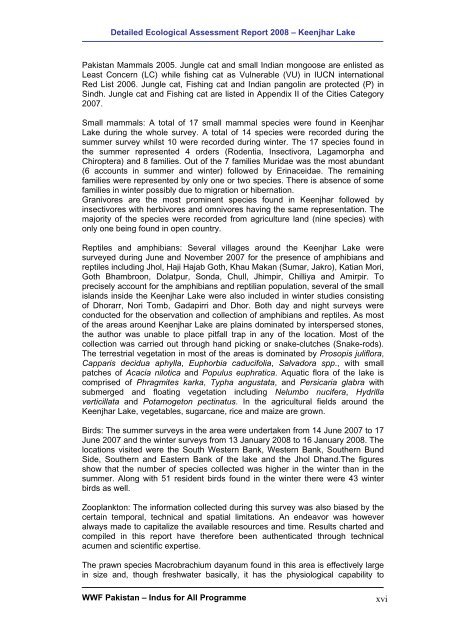Untitled - WWF - Pakistan
Untitled - WWF - Pakistan
Untitled - WWF - Pakistan
You also want an ePaper? Increase the reach of your titles
YUMPU automatically turns print PDFs into web optimized ePapers that Google loves.
Detailed Ecological Assessment Report 2008 – Keenjhar Lake<br />
<strong>Pakistan</strong> Mammals 2005. Jungle cat and small Indian mongoose are enlisted as<br />
Least Concern (LC) while fishing cat as Vulnerable (VU) in IUCN international<br />
Red List 2006. Jungle cat, Fishing cat and Indian pangolin are protected (P) in<br />
Sindh. Jungle cat and Fishing cat are listed in Appendix II of the Cities Category<br />
2007.<br />
Small mammals: A total of 17 small mammal species were found in Keenjhar<br />
Lake during the whole survey. A total of 14 species were recorded during the<br />
summer survey whilst 10 were recorded during winter. The 17 species found in<br />
the summer represented 4 orders (Rodentia, Insectivora, Lagamorpha and<br />
Chiroptera) and 8 families. Out of the 7 families Muridae was the most abundant<br />
(6 accounts in summer and winter) followed by Erinaceidae. The remaining<br />
families were represented by only one or two species. There is absence of some<br />
families in winter possibly due to migration or hibernation.<br />
Granivores are the most prominent species found in Keenjhar followed by<br />
insectivores with herbivores and omnivores having the same representation. The<br />
majority of the species were recorded from agriculture land (nine species) with<br />
only one being found in open country.<br />
Reptiles and amphibians: Several villages around the Keenjhar Lake were<br />
surveyed during June and November 2007 for the presence of amphibians and<br />
reptiles including Jhol, Haji Hajab Goth, Khau Makan (Sumar, Jakro), Katian Mori,<br />
Goth Bhambroon, Dolatpur, Sonda, Chull, Jhimpir, Chilliya and Amirpir. To<br />
precisely account for the amphibians and reptilian population, several of the small<br />
islands inside the Keenjhar Lake were also included in winter studies consisting<br />
of Dhorarr, Nori Tomb, Gadapirri and Dhor. Both day and night surveys were<br />
conducted for the observation and collection of amphibians and reptiles. As most<br />
of the areas around Keenjhar Lake are plains dominated by interspersed stones,<br />
the author was unable to place pitfall trap in any of the location. Most of the<br />
collection was carried out through hand picking or snake-clutches (Snake-rods).<br />
The terrestrial vegetation in most of the areas is dominated by Prosopis juliflora,<br />
Capparis decidua aphylla, Euphorbia caducifolia, Salvadora spp., with small<br />
patches of Acacia nilotica and Populus euphratica. Aquatic flora of the lake is<br />
comprised of Phragmites karka, Typha angustata, and Persicaria glabra with<br />
submerged and floating vegetation including Nelumbo nucifera, Hydrilla<br />
verticillata and Potamogeton pectinatus. In the agricultural fields around the<br />
Keenjhar Lake, vegetables, sugarcane, rice and maize are grown.<br />
Birds: The summer surveys in the area were undertaken from 14 June 2007 to 17<br />
June 2007 and the winter surveys from 13 January 2008 to 16 January 2008. The<br />
locations visited were the South Western Bank, Western Bank, Southern Bund<br />
Side, Southern and Eastern Bank of the lake and the Jhol Dhand.The figures<br />
show that the number of species collected was higher in the winter than in the<br />
summer. Along with 51 resident birds found in the winter there were 43 winter<br />
birds as well.<br />
Zooplankton: The information collected during this survey was also biased by the<br />
certain temporal, technical and spatial limitations. An endeavor was however<br />
always made to capitalize the available resources and time. Results charted and<br />
compiled in this report have therefore been authenticated through technical<br />
acumen and scientific expertise.<br />
The prawn species Macrobrachium dayanum found in this area is effectively large<br />
in size and, though freshwater basically, it has the physiological capability to<br />
<strong>WWF</strong> <strong>Pakistan</strong> – Indus for All Programme<br />
xvi
















